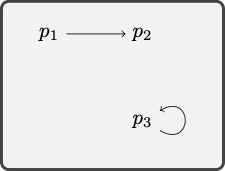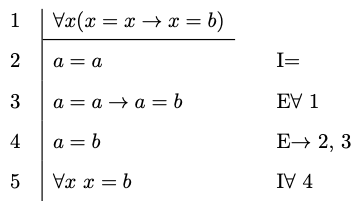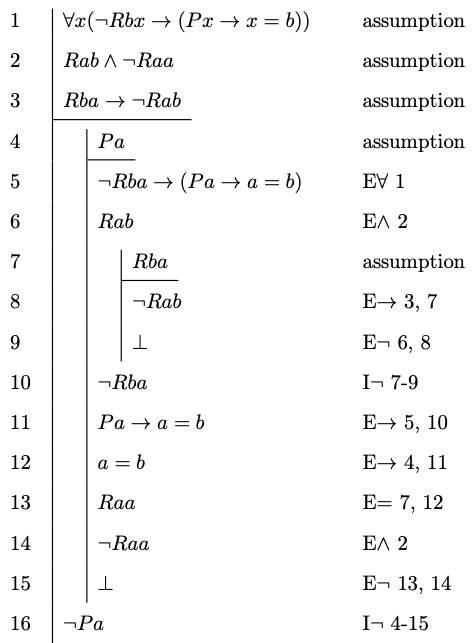9 Identity
We begin with a distinction between two important binary relations: numerical and qualitative identity. The relation of numerical identity is one an object bears to itself and to nothing else, and it is generally expressed by means of the predicate ‘is’ or ‘is identical to’. Unfortunately, that predicate is sometimes used to express a different relation, one that obtains between two objects if they are similar in every respect that may be relevant for the purposes of a conversation. We use the label ‘numerical identity’ for the first relation and the label ‘qualitative identity’ for the second.
- Qualitative Identity
-
Two objects are qualitatively identical when they share all of the same qualities.
If Alex and Beth bought two computers of the same make and with the same specifications and even the same color, we may be inclined to say:
- Alex and Beth bought (qualitative) identical computers.
- The computer Alex bought is identical to the computer Beth bought.
- Alex and Beth bought the same computer.
- Numerical Identity
-
We speak of numerical identity when two objects are one and the same.
If Alex and Beth do not own different computers but rather happen to share one and the same machine, we may be inclined to say:
- The computer Alex uses is (numerically) identical to the computer Beth uses.
- Alex and Beth use (one and) the same computer.
- Alex and Beth share (one and) the same computer.
Unfortunately, a variety of sentences are ambiguous between two interpretations of the relevant predicates:
- I have always used the same computer.
- The computer I bought last year is the same you bought now.
On the interpretation of the predicate ‘the same’ in terms of numerical identity, one and the same computer has been used throughout the years and one and the same computer had been bought by me one year ago and has been bought by you now. On the alternative interpretation in terms of qualitative identity, I have always used computers of the same make and specifications even if more than one, and the computer you bought now is of the same make and specifications as the one I had bought one year ago.
Syntax
Quantificational logic with identity expands the vocabulary of quantificational logic with a predicate
- Atomic Formula
-
All atomic formulas of quantificational logic remain atomic formulas of quantificational logic with identity. Furthermore, if
Example 9.1 Each of the expressions below are atomic formulas of quantificational logic with identity:
- Formula
-
We now define what is for an expression to be a formula of quantificational logic with identity.
- All atomic formulas are formulas.
- If
- If
- Nothing else is a formula.
All other definitions carry over without incident to the language of quantificational logic with identity.
Semantics
The semantics for quantificational logic with identity requires a minimal modification of the semantics for quantificational logic. We retain the definition of a model, an assignment for a model, and that of the denotation of a singular term relative to an assignment. We modify the definition of truth in a model relative to an assignment in order to accommodate atomic formulas of quantificational logic with identity.
Atomic Formulas
Example 9.2
Let
The rest of the definition of truth in a model relative to an assignment and truth in a model carries over to quantificational logic with identity without incident. So do the definitions of logical truth, equivalence, consistency, and validity.

Example 9.3 The formula
The model depicted by the diagram verifies the antecedent of the conditional but not the consequent.
The formula
The formula

Example 9.4 Consider the following argument:
The model depicted by the diagram verifies the premises but falsifies the conclusion.
The formula
The formula
The formula

Example 9.5 Consider the following argument:
This model depicted by the diagram verifies the premises but not the conclusion.
The formula
The formula
The formula
We conclude that the argument is invalid.
Natural Deduction
We now expand the natural deduction system for quantificational logic with introduction and elimination rules for identity.
There is a simple introduction rule for identity:

Identity Introduction
- Identity Introduction
-
You may write an identity
The rationale for this rule is that since as a matter of logic, all objects are self-identical, whatevery
Example 9.6


Identity Elimination
- Identity Elimination
-
You may substitute every occurrence of
The rationale for the elimination rule is that given
Example 9.7

Uses of Identity
We will use identity to translate overt identity statements such as ‘Mark Twain is Samuel Clemens’, which becomes
We now look at less overt uses of identity in natural language.
- Only
-
Only you arrived on time
Translation key
Every thing is such that it arrived on time only if it is identical to you.
- Else
-
You arrived on time, but someone else did as well.
Translation key
You arrived on time, and some thing is such that it is not identical to you and it arrived on time.
- Number
-
Identity enables us to translate a variety of statements of number.
Some statements of number say that there is at least a certain number of objects of a certain type:
- There are at least two books.
- There are at least three books.
Others tell us that there are at most a certain number of such objects:
- There is at most one book.
- There are at most two books.
There is of course no reason to use identity to translate ‘there is at least one book’ as
It is not difficult to generalize to other numbers, e.g., ‘there are at least four books’, etc. We are similarly able to offer the following translations for the sentences in the second group:
The generalization to other numbers is similarly straightforward.
We are now in a position to translate numerical statements whereby we state the existence of an exact number of objects of a certain type:
- There is exactly one book.
- There are exactly two books.
The crucial observation at this point is that each of these statements is equivalent to a conjunction of two statements we already know how to translate:
- There is at least one book and there is at most one book.
- There are at least two books and there are at most two books.
The translation of each of these conjunctions becomes:
But each of these formulas is equivalent to a more concise version:
- Definite Descriptions
-
The author of Huckleberry Finn is American
We now focus on phrases such as ‘the author of Huckleberry Finn’ or ‘instructor’, which combine the expression ‘the’ with a predicate. In quantificational logic, we treated all such expressions as designators, whose primary semantic function is to designate an object. But Bertrand Russell famously suggested that they should instead be treated as quantifier phrases. He offered the following style of paraphrase for sentences involving definite descriptions:
The instructor arrived on time.
Exactly one individual is an instructor and she arrived on time.
The author of Huckleberry Finn is American
Exactly one individual is author of Huckleberry Finn and he is American.
Given Russell’s paraphrase method, the first sentence translates as:
relative to a translation key on which
relative to a translation key on which
Exercises
For each set of formulas below, find a model we can use to justify the fact that the set is consistent. Please justify your answers.
For each argument below, find a model we can use to justify the fact that the argument is invalid. Please justify your answers.
Provide a natural deduction proof to justify each of the claims below: